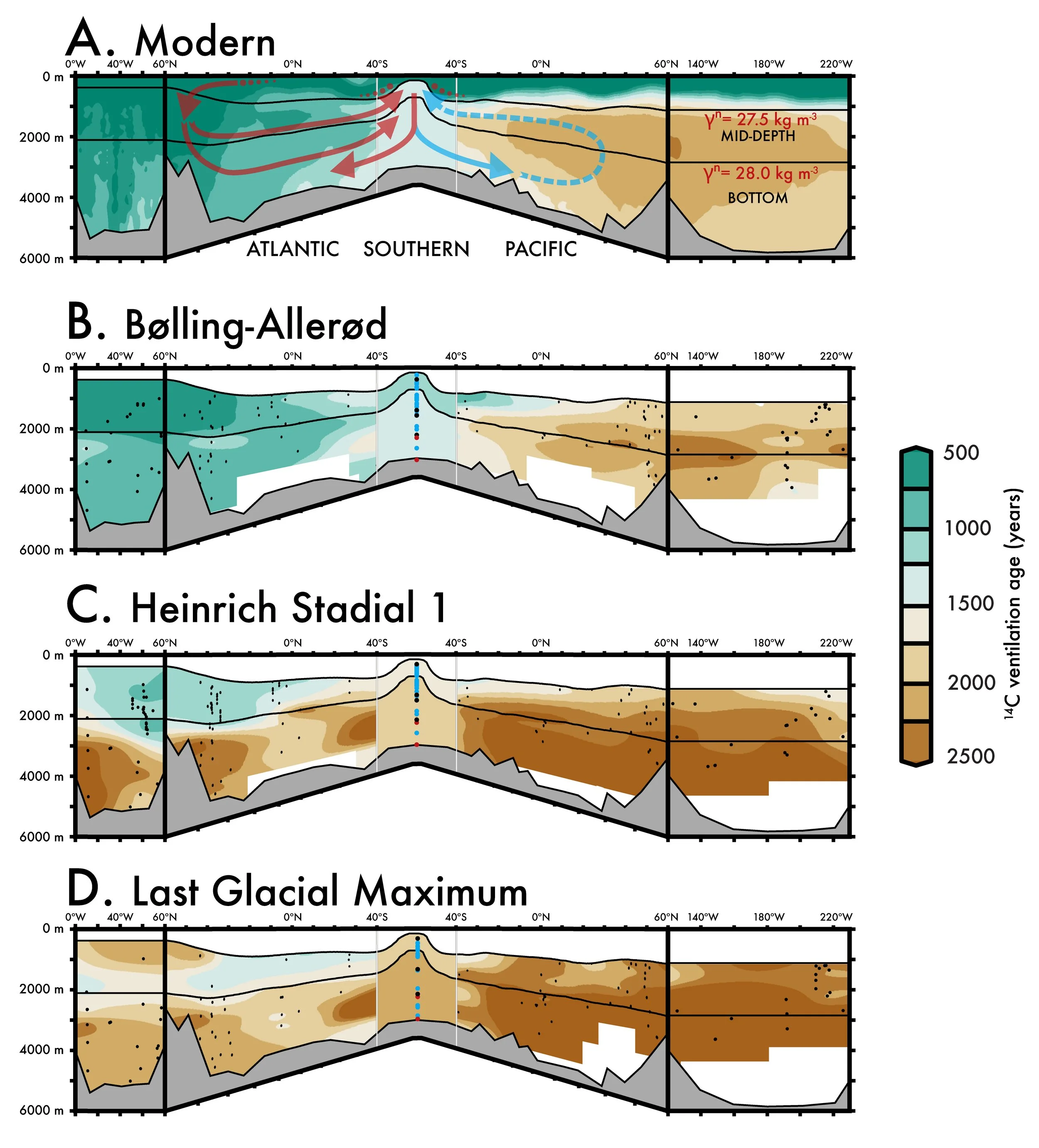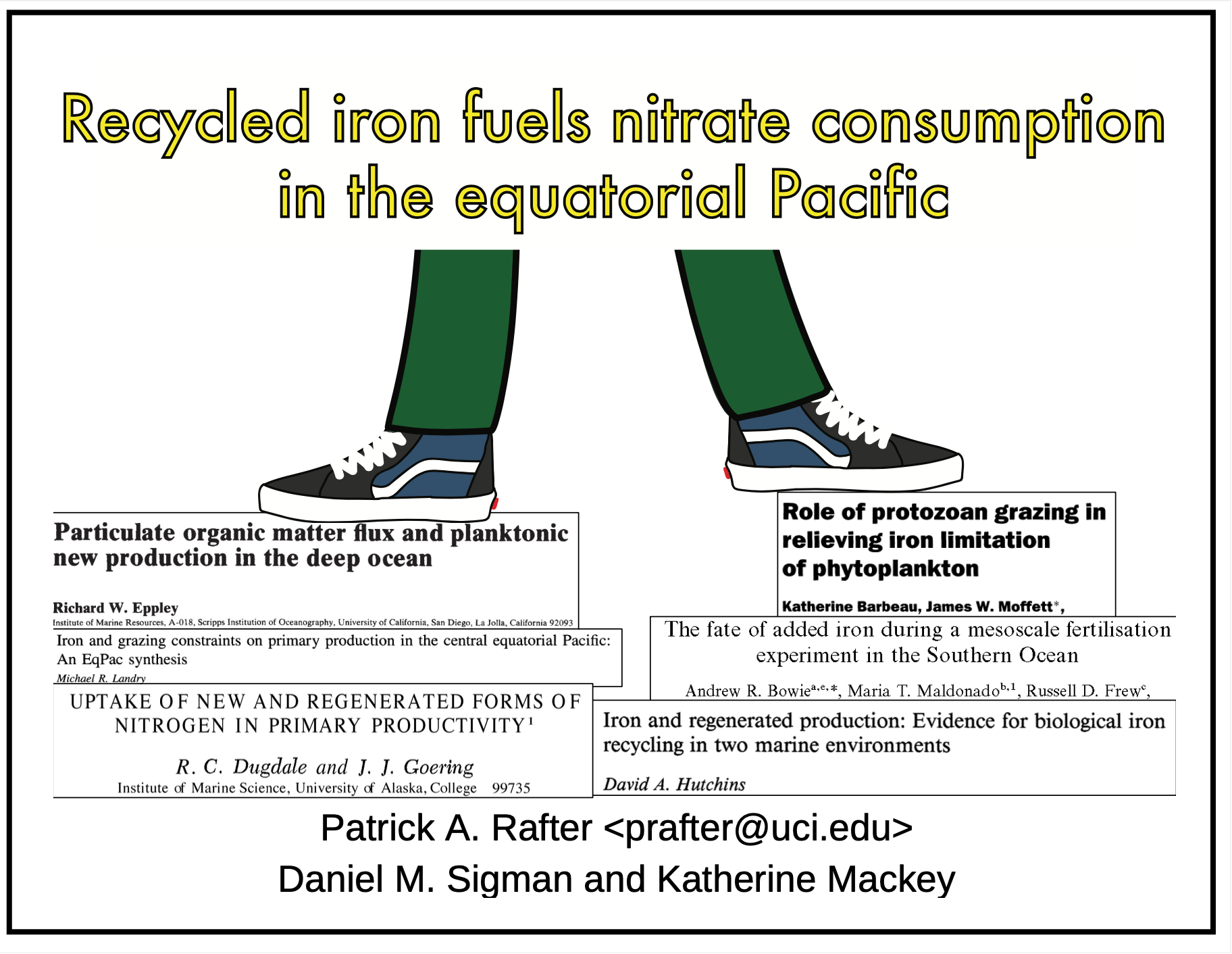RESEARCH AREAS
OCEAN CARBON CYCLING
IN THE PAST
(OCEAN VENTILATION)
How did carbon (as carbon dioxide) go into and out of the global ocean before humans tweaked the global carbon cycle? Rafter is deliberately working towards answers to some of the biggest questions about this “natural” air-sea carbon cycling.
First, Rafter provide solid evidence that past seawater 14C/C can be accurately reconstructed using marine microfossil radiocarbon measurements (Rafter et al. 2018). Using these results, Rafter was awarded an NSF award to constrain glacial-interglacial changes in seawater carbon chemistry (OCE#2015647). A related project examines the contribution of geologic carbon to the global ocean via new proxy measurements of seawater pH and modeling (see above).
New work has pulled together all proxy measurements of seawater 14C, to provide a global view of changing deep-sea ventilation as the world warms from the last ice age (see image to right; published in Science Advances).
And a new proposal (to be resubmitted) aims to fill in a critical gap in our knowledge of global ocean overturning since the last ice age, with several (n=6) new glacial-interglacial 14C records from the deep Indian Ocean. Following this, there will be additional proposals to evaluate the regional differences in deep-sea 14C ventilation age, such as the NW vs. NE Atlantic.
OCEAN CARBON CYCLING
IN THE FUTURE
(mCDR MRV)
A new area of research involves developing quantitative methods for “Measuring, Reporting, and Verification” (MRV) of ocean carbon dioxide removal (CDR). Specifically, we are working to see if the stable isotopic composition of carbon (“d13C”) is a useful tool for quantifying the additional CO2 uptake alongside marine CDR deployments.
However, we are also using these tools to simply better understand the movement of CO2 between the atmosphere and ocean. This takes a variety of forms, mostly—but not entirely—focused on marine biogeochemistry, carbon fixation in the ocean, and more.
OCEAN CARBON CYCLING
IN THE PAST
(SEAFLOOR SOURCES?)
One new area of research involves the “natural” input of alkalinity (and DIC) to the ocean in the form of bicarbonate (HCO3-). Here’s the story: Using paleoceanographic data (detailed below), we argue in (Rafter et al. 2019) that the observed changes in Gulf of California chemistry require a combination of known sedimentary processes (pyrolysis of sedimentary carbonates to methane followed by the anaerobic oxidation of methane by archaea). We hypothesize that this produces a net flux of HCO3- from the seafloor, ultimately: (1) Adding DIC to the water column, (2) Lowering seawater DIC radiocarbon, (3) No change in pH.
This novel connection of known processes was made possible by a “Paleo pCO2 fellowship” to PI Rafter to make proxy measurements of past seawater pH (using boron isotopes). Furthermore, Rafter used this preliminary data to obtain NSF funding to make more proxy seawater pH measurements (with James Rae / Will Gray) and model the proposed geochemical processes and their consequences (with Mathis Hain) (NSF grant #OCE 2032340).
CLIMATE CHANGE
IN THE PAST
Some of my work targets well known climate variability, typically by using my expertise as an isotope geochemist. For example…
Evidence that long-term El Niño Southern Oscillation (ENSO) variability—the largest source of modern climate variability—is insensitive to atmospheric carbon dioxide (CO2). (Rafter and Charles 2012)
Confirming the air-sea decadal variability called the North Pacific Gyre Oscillation (NPGO) and its influence on coastal California upwelling and seawater carbon chemistry. (Rafter et al. 2017)
Testing for changes in equatorial Pacific thermocline (and by proxy ENSO) during the high CO2 of the Pliocene
(ms in prep; NSF grant #OCE1635610)
MARINE NITROGEN CYCLING
Without resupply, surface ocean nutrients (and therefore productivity and carbon export to the deep-sea) would cease.
In a series of papers, I used nitrate isotopes and machine learning to identify how the nutrient nitrate resupplies the global surface ocean—from the Southern Ocean to wherever. (Rafter et al. 2012; Rafter et al. 2013; Rafter et al. 2019 BGC)
Other work first identified, then quantified the need for iron recycling to fuel nitrate consumption (and therefore the growth of phytoplankton most likely to sequester carbon at depth). (Rafter et al. 2017)
Surface ocean nitrogen cycling is most frequently reconstructed (i.e., by proxy) via the bulk sediment N isotope. I was funded by NSF to test preliminary bulk results (suggesting no change in equatorial Pacific air-sea dynamics over 5 million years) with “microfossil-bound” N isotopes (ms in prep; the same NSF grant #OCE1635610).
I co-authored many more papers on the global supply and uptake of nitrate (see CV).



